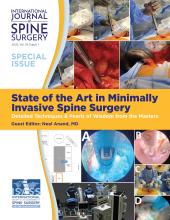ABSTRACT
Background This is a brief technical report about a novel regional anesthesia technique in which local anesthetic was deposited around the thoracolumbar dorsal rami nerves via 4 multiorifice pain catheters to obtain analgesia for posterior spinal fusion surgery on scoliosis patients. Scoliosis is the most common deformity of the spine. Currently, most surgeons prefer a dual rod, segmental spinal fixation system that allows multiple anchor points for attachment to the deformed spine. Scoliosis surgery is an extremely painful surgical procedure due to the large incision, surgical trauma to superficial and deep muscles of the back, and the insertion of pedicle screws and metal rods directly into the vertebral column. Postoperative pain management remains very challenging.
Methods Three patients presented with scoliosis. Intraoperatively, 4 multiorifice catheters were placed lateral to the implanted pedicle screws. Two catheters were placed on each side, and a continuous infusion of 0.2 % ropivacaine was initiated postoperatively to improve the patient's pain control. The catheters remained in place for 48 hours postoperatively and were removed by the surgical team. Gentle traction was applied similar to the way epidural catheters are removed.
Results All 3 patients reported very low pain scores, low doses of opioid consumption, and satisfaction with their pain control throughout their hospitalization.
Conclusions Our study results suggest that a thoracolumbar dorsal ramus nerve block using continuous multiorifice infusion catheters significantly improved postoperative comfort and pain and that its implementation into a multimodal analgesic regimen is relatively easy to achieve.
- thoracolumbar dorsal ramus nerve block
- multiorifice pain catheters
- scoliosis surgery
- posterior spinal fusion surgery
- postoperative pain management
Footnotes
Disclosures and COI: The authors declare no conflict of interest; there are no financial or funding source(s) that support this work. Written informed consent was obtained from the patients for publication of this brief technical report and any accompanying images.
- ©International Society for the Advancement of Spine Surgery







